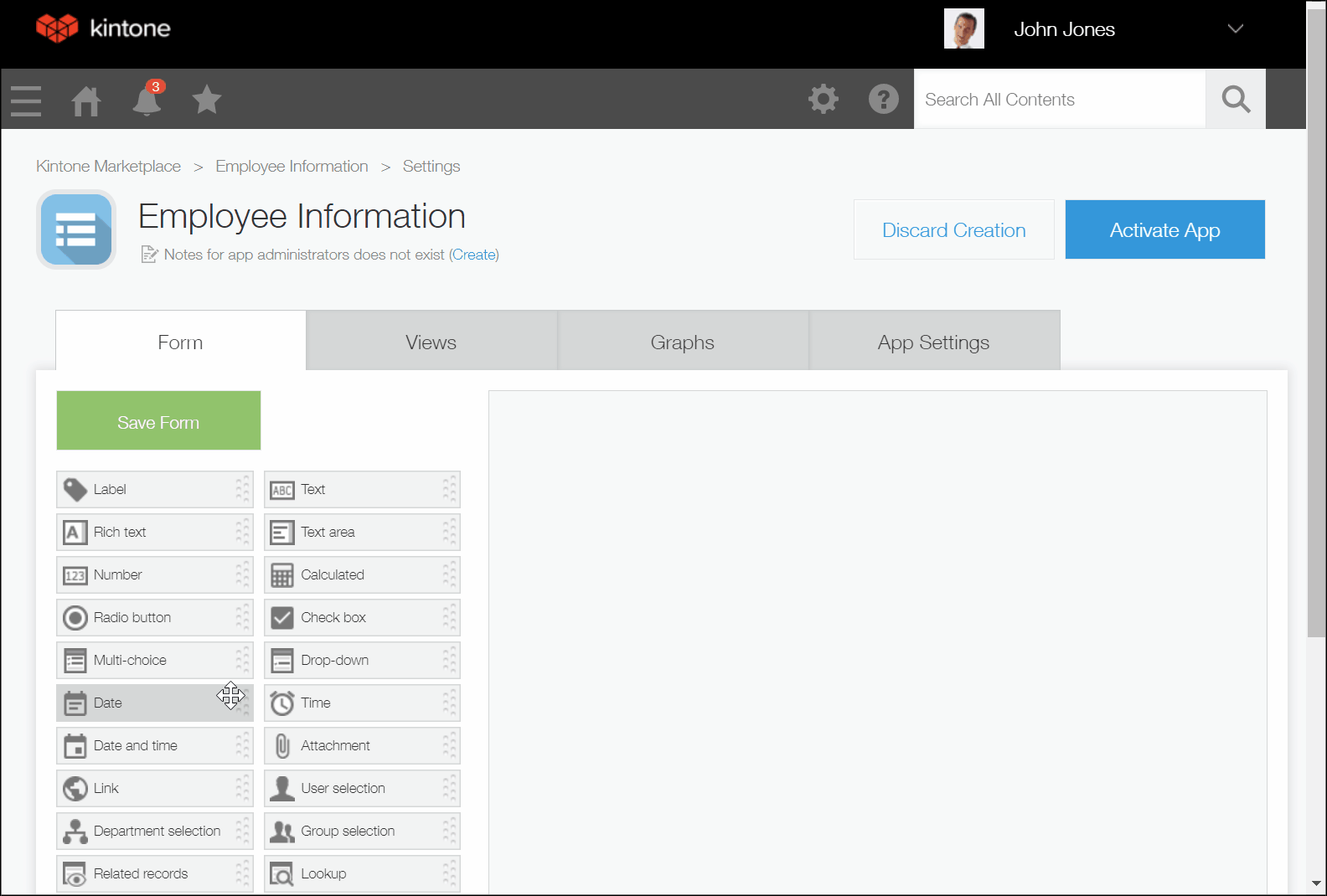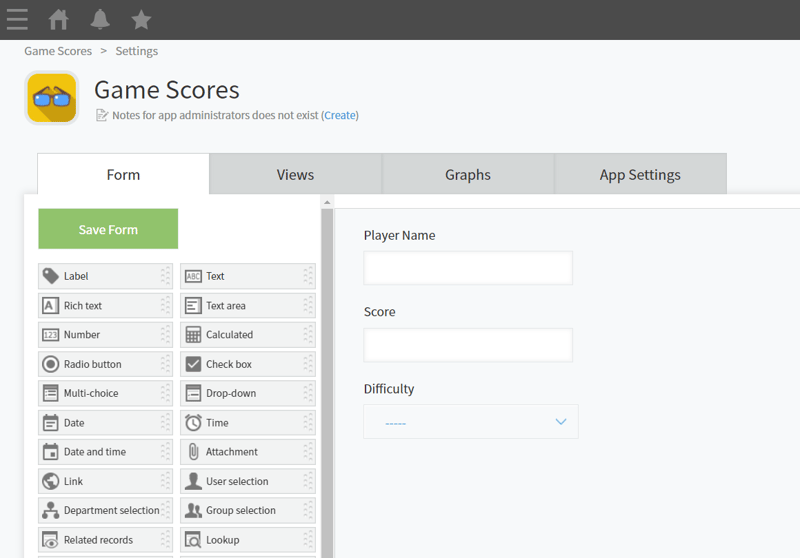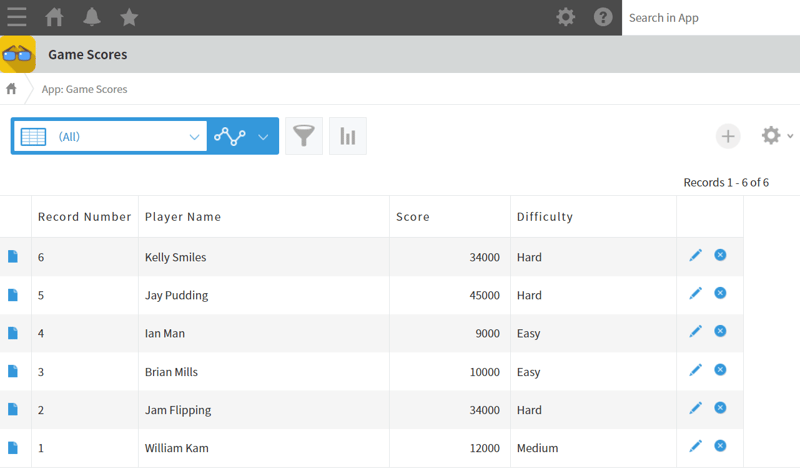ハッカソンでkintoneを使うためのヒント
Introduction
When you're participating in a hackathon, efficiency and quick iteration are key to success. One tool that can help you manage data efficiently is Kintone, a powerful no-code/low-code platform that allows you to create web-based databases with ease.
In this guide, we'll walk you through how to create a simple Kintone App to store scores for games, and demonstrate how to interact with the Kintone API using some local Python code.
Get your Kintone Environment
First we need to get our hands on a Kintone Environment!
Developers are entitled to use the Kintone Developer License - an environment that can be used for free for 1 year ❤
Get your Kintone Developer License by filling out the form.
https://kintone.dev/en/developer-license-registration-form/
Create your Kintone Database
Web Databases in Kintone are called "Apps".
Creating these Apps are easy in Kintone - you can drag-and-drop the fields that you need, without needing to code.

Follow the instructions on the following link to create a new App.
https://get.kintone.help/k/en/id/040133.html
These are the fields we will include in the Kintone App for this article:
| Field Type | Field Name | Field Code |
|---|---|---|
| Text | Player Name | playername |
| Number | Score | score |
| Text | Difficulty | difficulty |
The field layout should look like the following:

After that, proceed to the Settings tab, and generate an API Token that will be used for the authentication. Set the permissions for View records and Add records.
https://get.kintone.help/k/en/id/040471.html
Once this is done, save the settings, and click on the blue "Activate App" button.
Manually Input Some Data
Since there is no data yet inside the App, manually add in some data so that we have something to work with.
https://get.kintone.help/k/en/id/040715.html

Now we're ready to interact with the Web Database with some Python code!
Sample Python Code to Interact with Kintone
Now that your app is set up, let's look at how you can interact with the Kintone API using Python. We'll cover how to add a record, retrieve all records, and query records based on difficulty.
Get a Python environment ready on your local machine. Since we will be using the requests library to make our API calls, install the library with the following command:
pip install requests
1. Adding a Record to the Kintone App
Below is a sample Python script that adds a new record to the Kintone App.
import requests
import json
def add_record():
API_endpoint = "https://{YOUR_SUBDOMAIN}.cybozu.com/k/v1/record.json"
app_id = "{APP_ID}"
kintone_headers = {
"X-Cybozu-API-Token": "{API_TOKEN}",
"Content-Type": "application/json"
}
bodydata = {
"app": app_id,
"record": {
"player": {
"value": "John Doe"
},
"score": {
"value": "1500"
},
"diff": {
"value": "Medium"
}
}
}
try:
response = requests.post(API_endpoint, headers=kintone_headers, data=json.dumps(bodydata))
jsondata = response.json()
print(jsondata)
except requests.exceptions.RequestException as error:
print(error)
add_record()
The App ID is a number that can be found in the URL of the Kintone App.
If the request is successful, a JSON is responded that includes the ID of the newly added record.
{'id': '7', 'revision': '1'}
If the request is successful, but the record data is empty, it may be because the keys inside the body data were incorrect. Make sure that the keys for the fields are stated as their field codes, and not their field names.
2. Retrieving All Records from the Kintone App
The following Python script will retrieve all records stored in your Kintone App.
import requests
def get_all_records():
API_endpoint = "https://{YOUR_SUBDOMAIN}.cybozu.com/k/v1/records.json"
app_id = "{APP_ID}"
API_endpoint = API_endpoint "?app=" app_id
kintone_headers = {
"X-Cybozu-API-Token": "{API_TOKEN}",
}
try:
response = requests.get(API_endpoint, headers=kintone_headers)
jsondata = response.json()
print(jsondata)
except requests.exceptions.RequestException as error:
print(error)
get_all_records()
If the request is successful, the response will include a JSON of all the records in the App.
"records": [
{
"difficulty": {
"type": "DROP_DOWN",
"value": null
},
"score": {
"type": "NUMBER",
"value": "1500"
},
"Record Number": {
"type": "RECORD_NUMBER",
"value": "7"
},
"Updated By": {
"type": "MODIFIER",
"value": {
"code": "Administrator",
"name": "Administrator"
}
},
"Created By": {
"type": "CREATOR",
"value": {
"code": "Administrator",
"name": "Administrator"
}
},
"playername": {
"type": "SINGLE_LINE_TEXT",
"value": ""
},
"$revision": {
"type": "__REVISION__",
"value": "1"
},
"Updated Datetime": {
"type": "UPDATED_TIME",
"value": "2024-10-06T02:33:00Z"
},
"Created Datetime": {
"type": "CREATED_TIME",
"value": "2024-10-06T02:33:00Z"
},
"$id": {
"type": "__ID__",
"value": "7"
}
},
{
"difficulty": {
"type": "DROP_DOWN",
"value": "Hard"
},
"score": {
"type": "NUMBER",
"value": "34000"
},
"Record Number": {
"type": "RECORD_NUMBER",
"value": "6"
},
"Updated By": {
"type": "MODIFIER",
"value": {
"code": "will",
"name": "will-yama"
}
},
"Created By": {
"type": "CREATOR",
"value": {
"code": "will",
"name": "will-yama"
}
},
"playername": {
"type": "SINGLE_LINE_TEXT",
"value": "Kelly Smiles"
},
"$revision": {
"type": "__REVISION__",
"value": "1"
},
"Updated Datetime": {
"type": "UPDATED_TIME",
"value": "2024-10-06T01:41:00Z"
},
"Created Datetime": {
"type": "CREATED_TIME",
"value": "2024-10-06T01:41:00Z"
},
"$id": {
"type": "__ID__",
"value": "6"
}
},...
We have cut off the above JSON response half way through for this article, as it is quite long.
3. Retrieving Records with Query Filtering
In some cases, you may want to retrieve records based on specific conditions, such as fetching records where the difficulty is set to "Hard". Add a query to the GET request to achieve this.
import requests
def get_all_records():
API_endpoint = "https://{YOUR_SUBDOMAIN}.cybozu.com/k/v1/records.json"
app_id = "{APP_ID}"
query = "difficulty in (\"Hard\")"
API_endpoint = API_endpoint "?app=" app_id "&query=" query
kintone_headers = {
"X-Cybozu-API-Token": "{API_TOKEN}",
}
try:
response = requests.get(API_endpoint, headers=kintone_headers)
jsondata = response.json()
print(jsondata)
except requests.exceptions.RequestException as error:
print(error)
get_all_records()
If the request is successful, the response will include a JSON of the filtered records.
"records": [
{
"difficulty": {
"type": "DROP_DOWN",
"value": "Hard"
},
"score": {
"type": "NUMBER",
"value": "34000"
},
"Record Number": {
"type": "RECORD_NUMBER",
"value": "6"
},
"Updated By": {
"type": "MODIFIER",
"value": {
"code": "will",
"name": "William Sayama"
}
},
"Created By": {
"type": "CREATOR",
"value": {
"code": "will",
"name": "William Sayama"
}
},
"playername": {
"type": "SINGLE_LINE_TEXT",
"value": "Kelly Smiles"
},
"$revision": {
"type": "REVISION",
"value": "1"
},
"Updated Datetime": {
"type": "UPDATED_TIME",
"value": "2024-10-06T01:41:00Z"
},
"Created Datetime": {
"type": "CREATED_TIME",
"value": "2024-10-06T01:41:00Z"
},
"$id": {
"type": "ID",
"value": "6"
}
},
{
"difficulty": {
"type": "DROP_DOWN",
"value": "Hard"
},
"score": {
"type": "NUMBER",
"value": "45000"
},
"Record Number": {
"type": "RECORD_NUMBER",
"value": "5"
},
"Updated By": {
"type": "MODIFIER",
"value": {
"code": "will",
"name": "William Sayama"
}
},
"Created By": {
"type": "CREATOR",
"value": {
"code": "will",
"name": "William Sayama"
}
},
"playername": {
"type": "SINGLE_LINE_TEXT",
"value": "Jay Pudding"
},
"$revision": {
"type": "REVISION",
"value": "1"
},
"Updated Datetime": {
"type": "UPDATED_TIME",
"value": "2024-10-06T01:38:00Z"
},
"Created Datetime": {
"type": "CREATED_TIME",
"value": "2024-10-06T01:38:00Z"
},
"$id": {
"type": "ID",
"value": "5"
}
},
{
"difficulty": {
"type": "DROP_DOWN",
"value": "Hard"
},
"score": {
"type": "NUMBER",
"value": "34000"
},
"Record Number": {
"type": "RECORD_NUMBER",
"value": "2"
},
"Updated By": {
"type": "MODIFIER",
"value": {
"code": "will",
"name": "William Sayama"
}
},
"Created By": {
"type": "CREATOR",
"value": {
"code": "will",
"name": "William Sayama"
}
},
"playername": {
"type": "SINGLE_LINE_TEXT",
"value": "Jam Flipping"
},
"$revision": {
"type": "REVISION",
"value": "2"
},
"Updated Datetime": {
"type": "UPDATED_TIME",
"value": "2024-10-06T01:38:00Z"
},
"Created Datetime": {
"type": "CREATED_TIME",
"value": "2024-10-05T01:26:00Z"
},
"$id": {
"type": "ID",
"value": "2"
}
}
],
"totalCount": null
Conclusion
By setting up a Kintone App and interacting with it via API, you can easily manage data for your projects. Whether you're keeping track of player performances or storing other types of data, Kintone’s flexible API makes it easy to integrate into any hackathon project.
This guide has provided examples for adding records, retrieving all records, and querying records with specific conditions, allowing you to customize your data management according to your needs.
Good luck at your hackathon, and happy coding with Kintone!
-
 PHPを使用してBlob(画像)をMySQLに適切に挿入する方法は?php mysqlデータベースを持つmysqlデータベースにブロブを挿入すると、mysqlデータベースに画像を保存しようとすると、遭遇するかもしれません問題。このガイドは、画像データを正常に保存するためのソリューションを提供します。 ImageId、image) values( &...プログラミング 2025-04-28に投稿されました
PHPを使用してBlob(画像)をMySQLに適切に挿入する方法は?php mysqlデータベースを持つmysqlデータベースにブロブを挿入すると、mysqlデータベースに画像を保存しようとすると、遭遇するかもしれません問題。このガイドは、画像データを正常に保存するためのソリューションを提供します。 ImageId、image) values( &...プログラミング 2025-04-28に投稿されました -
 UTF8 MySQLテーブルでLATIN1文字をUTF8に正しく変換する方法latin1文字をUTF8テーブル内のutf8に変換する diaCriticsのキャラクターが遭遇した問題に遭遇しました( "Jáuòiñe")がUTF8テーブルで存在していないために、utf8テーブルが不足しているために存在していませんでした。 「mysql_se...プログラミング 2025-04-28に投稿されました
UTF8 MySQLテーブルでLATIN1文字をUTF8に正しく変換する方法latin1文字をUTF8テーブル内のutf8に変換する diaCriticsのキャラクターが遭遇した問題に遭遇しました( "Jáuòiñe")がUTF8テーブルで存在していないために、utf8テーブルが不足しているために存在していませんでした。 「mysql_se...プログラミング 2025-04-28に投稿されました -
 3つのMySQLテーブルのデータを新しいテーブルに組み合わせる方法は?mysql:3つのテーブルのデータと列から新しいテーブルを作成する 質問: 人々、詳細、および分類表の表? P。*、d.contentを年齢として選択します psとしての人々から D.Person_id = p.idのDとして詳細を結合します t.id = d.detail_idでt...プログラミング 2025-04-28に投稿されました
3つのMySQLテーブルのデータを新しいテーブルに組み合わせる方法は?mysql:3つのテーブルのデータと列から新しいテーブルを作成する 質問: 人々、詳細、および分類表の表? P。*、d.contentを年齢として選択します psとしての人々から D.Person_id = p.idのDとして詳細を結合します t.id = d.detail_idでt...プログラミング 2025-04-28に投稿されました -
 「JSON」パッケージを使用してGOでJSONアレイを解析する方法は?json arrays in jsonパッケージ 問題: 次のGOコードを検討してください: タイプjsontype struct { 配列[]文字列 } func main(){ datajson:= `[" 1 "、" 2 "...プログラミング 2025-04-28に投稿されました
「JSON」パッケージを使用してGOでJSONアレイを解析する方法は?json arrays in jsonパッケージ 問題: 次のGOコードを検討してください: タイプjsontype struct { 配列[]文字列 } func main(){ datajson:= `[" 1 "、" 2 "...プログラミング 2025-04-28に投稿されました -
 FASTAPIカスタム404ページ作成ガイドcustom 404 Fastapi を備えたPage not inound Page not foundページを作成するには、Fastapiがいくつかのアプローチを提供します。適切な方法は、特定の要件に依存します。 call_next(リクエスト) response.status_c...プログラミング 2025-04-28に投稿されました
FASTAPIカスタム404ページ作成ガイドcustom 404 Fastapi を備えたPage not inound Page not foundページを作成するには、Fastapiがいくつかのアプローチを提供します。適切な方法は、特定の要件に依存します。 call_next(リクエスト) response.status_c...プログラミング 2025-04-28に投稿されました -
 Spring Security 4.1以降でCORSの問題を解決するためのガイドスプリングセキュリティCORSフィルター:一般的な問題のトラブルシューティング 既存のプロジェクトにスプリング関連エラーを統合する場合、「Access-Control-Origin」のようなヘッダーが応答に設定されていない場合にCORS関連のエラーに遭遇する場合があります。これを解決するに...プログラミング 2025-04-28に投稿されました
Spring Security 4.1以降でCORSの問題を解決するためのガイドスプリングセキュリティCORSフィルター:一般的な問題のトラブルシューティング 既存のプロジェクトにスプリング関連エラーを統合する場合、「Access-Control-Origin」のようなヘッダーが応答に設定されていない場合にCORS関連のエラーに遭遇する場合があります。これを解決するに...プログラミング 2025-04-28に投稿されました -
 動的にサイズの親要素内の要素のスクロール範囲を制限する方法は?垂直スクロール要素のcss高さ制限の実装 インタラクティブインターフェイスで、要素のスクロール挙動を制御することは、ユーザーエクスペリエンスとアクセシビリティを確保するために不可欠です。そのようなシナリオの1つは、動的にサイズの親要素内の要素のスクロール範囲を制限することです。ただし、マッ...プログラミング 2025-04-28に投稿されました
動的にサイズの親要素内の要素のスクロール範囲を制限する方法は?垂直スクロール要素のcss高さ制限の実装 インタラクティブインターフェイスで、要素のスクロール挙動を制御することは、ユーザーエクスペリエンスとアクセシビリティを確保するために不可欠です。そのようなシナリオの1つは、動的にサイズの親要素内の要素のスクロール範囲を制限することです。ただし、マッ...プログラミング 2025-04-28に投稿されました -
 順序付けられていないコレクションにタプルの一般的なハッシュ関数を実装する方法は?std :: unordered_mapとunordered_setコンテナは、ハスド値に基づいて効率的なルックアップと元素の挿入を提供します。ただし、カスタムハッシュ関数を定義せずにこれらのコレクションのキーとしてタプルを使用すると、予期しない動作につながる可能性があります。 st...プログラミング 2025-04-28に投稿されました
順序付けられていないコレクションにタプルの一般的なハッシュ関数を実装する方法は?std :: unordered_mapとunordered_setコンテナは、ハスド値に基づいて効率的なルックアップと元素の挿入を提供します。ただし、カスタムハッシュ関数を定義せずにこれらのコレクションのキーとしてタプルを使用すると、予期しない動作につながる可能性があります。 st...プログラミング 2025-04-28に投稿されました -
 PHPを使用してXMLファイルから属性値を効率的に取得するにはどうすればよいですか?php のXMLファイルから属性値を取得するすべての開発者は、XMLファイルを解析して特定の値を抽出する必要性に遭遇します。提供されている例のような属性を含むXMLファイルを使用する場合: $xml = simplexml_load_file($file); foreach ($xm...プログラミング 2025-04-28に投稿されました
PHPを使用してXMLファイルから属性値を効率的に取得するにはどうすればよいですか?php のXMLファイルから属性値を取得するすべての開発者は、XMLファイルを解析して特定の値を抽出する必要性に遭遇します。提供されている例のような属性を含むXMLファイルを使用する場合: $xml = simplexml_load_file($file); foreach ($xm...プログラミング 2025-04-28に投稿されました -
 右のテーブルの句でフィルタリングするとき、なぜ左結合が接続内に見えるのですか?left join conundrum:witching時間:データベースウィザードの領域で内側の結合 に変わる時間は、左結合を使用して複雑なデータ検索を実行することは一般的な慣行です。ただし、時々、左の結合が予想通りに動作しないことがあります。 A.foo、 B.BAR、 C.Foobar...プログラミング 2025-04-28に投稿されました
右のテーブルの句でフィルタリングするとき、なぜ左結合が接続内に見えるのですか?left join conundrum:witching時間:データベースウィザードの領域で内側の結合 に変わる時間は、左結合を使用して複雑なデータ検索を実行することは一般的な慣行です。ただし、時々、左の結合が予想通りに動作しないことがあります。 A.foo、 B.BAR、 C.Foobar...プログラミング 2025-04-28に投稿されました -
 JavaScriptオブジェクトにキーを動的に設定する方法は?JavaScriptオブジェクト変数の動的キーを作成する方法 この構文jsObj['key' i] = 'example' 1; はjavascriptで、アレイは特殊なタイプのオブジェクトです。この特別な動作は標準のオブジェクトによって模倣されていませんが、四角いブラケット演算子は...プログラミング 2025-04-28に投稿されました
JavaScriptオブジェクトにキーを動的に設定する方法は?JavaScriptオブジェクト変数の動的キーを作成する方法 この構文jsObj['key' i] = 'example' 1; はjavascriptで、アレイは特殊なタイプのオブジェクトです。この特別な動作は標準のオブジェクトによって模倣されていませんが、四角いブラケット演算子は...プログラミング 2025-04-28に投稿されました -
 Java開発者は、データベースの資格情報を逆コンパイルからどのように保護しますか?データベース資格情報をJava のjavaで保護することは、クラスファイルを比較的簡単です。これは、データベース資格情報などの機密データがコード内でハードコーディングされている場合、セキュリティの懸念をもたらします。この情報を保護するには、実行可能なコードからそれを分離することが不可欠に...プログラミング 2025-04-28に投稿されました
Java開発者は、データベースの資格情報を逆コンパイルからどのように保護しますか?データベース資格情報をJava のjavaで保護することは、クラスファイルを比較的簡単です。これは、データベース資格情報などの機密データがコード内でハードコーディングされている場合、セキュリティの懸念をもたらします。この情報を保護するには、実行可能なコードからそれを分離することが不可欠に...プログラミング 2025-04-28に投稿されました -
 マウスクリック時にDiv内のすべてのテキストをプログラム的に選択するにはどうすればよいですか?マウスクリックでプログラムをプログラム的に選択する 質問 テキストコンテンツのdiv要素が与えられた場合、ユーザーは1つのマウスクリックでdiv内のテキスト全体をプログラム的に選択できますか?これにより、ユーザーは選択したテキストを簡単にドラッグアンドドロップしたり、直接コピーしたりできます。...プログラミング 2025-04-28に投稿されました
マウスクリック時にDiv内のすべてのテキストをプログラム的に選択するにはどうすればよいですか?マウスクリックでプログラムをプログラム的に選択する 質問 テキストコンテンツのdiv要素が与えられた場合、ユーザーは1つのマウスクリックでdiv内のテキスト全体をプログラム的に選択できますか?これにより、ユーザーは選択したテキストを簡単にドラッグアンドドロップしたり、直接コピーしたりできます。...プログラミング 2025-04-28に投稿されました -
 Firefoxバックボタンを使用すると、JavaScriptの実行が停止するのはなぜですか?navigational Historyの問題:JavaScriptは、Firefoxバックボタンを使用した後に実行を停止します ユーザーは、JavaScriptスクリプトが以前の訪問ページを介して回復したときに実行されない問題に遭遇する可能性があります。この問題は、ChromeやInt...プログラミング 2025-04-27に投稿されました
Firefoxバックボタンを使用すると、JavaScriptの実行が停止するのはなぜですか?navigational Historyの問題:JavaScriptは、Firefoxバックボタンを使用した後に実行を停止します ユーザーは、JavaScriptスクリプトが以前の訪問ページを介して回復したときに実行されない問題に遭遇する可能性があります。この問題は、ChromeやInt...プログラミング 2025-04-27に投稿されました -
 Javaが一般的な配列を作成できないのはなぜですか?generic array作成エラー 質問: ; public static ArrayList<myObject>[] a = new ArrayList<myObject>[2];プログラミング 2025-04-27に投稿されました
Javaが一般的な配列を作成できないのはなぜですか?generic array作成エラー 質問: ; public static ArrayList<myObject>[] a = new ArrayList<myObject>[2];プログラミング 2025-04-27に投稿されました
中国語を勉強する
- 1 「歩く」は中国語で何と言いますか? 走路 中国語の発音、走路 中国語学習
- 2 「飛行機に乗る」は中国語で何と言いますか? 坐飞机 中国語の発音、坐飞机 中国語学習
- 3 「電車に乗る」は中国語で何と言いますか? 坐火车 中国語の発音、坐火车 中国語学習
- 4 「バスに乗る」は中国語で何と言いますか? 坐车 中国語の発音、坐车 中国語学習
- 5 中国語でドライブは何と言うでしょう? 开车 中国語の発音、开车 中国語学習
- 6 水泳は中国語で何と言うでしょう? 游泳 中国語の発音、游泳 中国語学習
- 7 中国語で自転車に乗るってなんて言うの? 骑自行车 中国語の発音、骑自行车 中国語学習
- 8 中国語で挨拶はなんて言うの? 你好中国語の発音、你好中国語学習
- 9 中国語でありがとうってなんて言うの? 谢谢中国語の発音、谢谢中国語学習
- 10 How to say goodbye in Chinese? 再见Chinese pronunciation, 再见Chinese learning

























